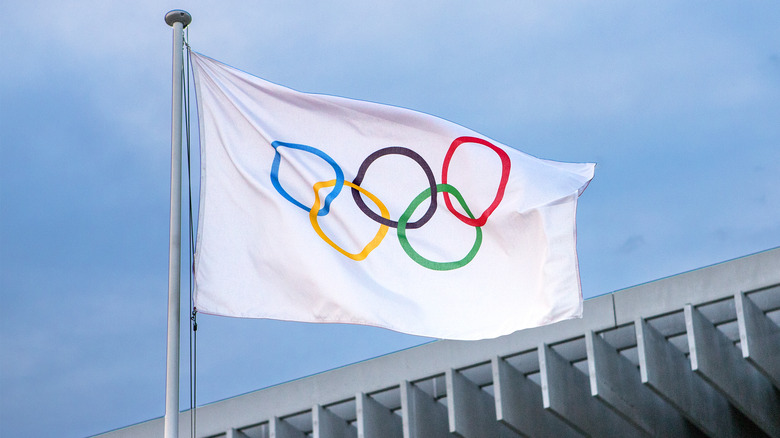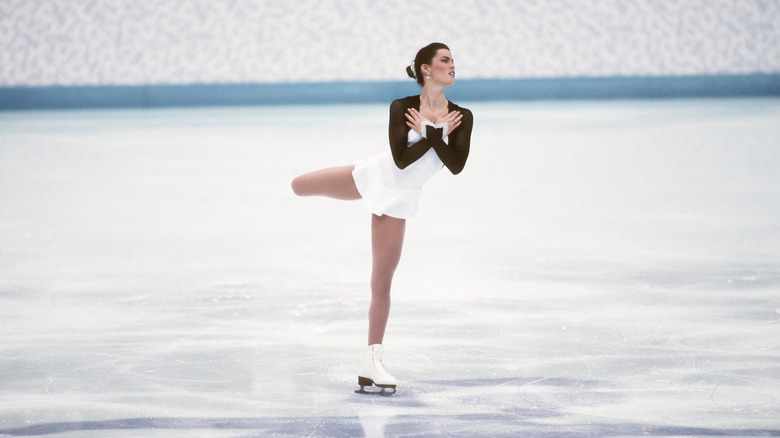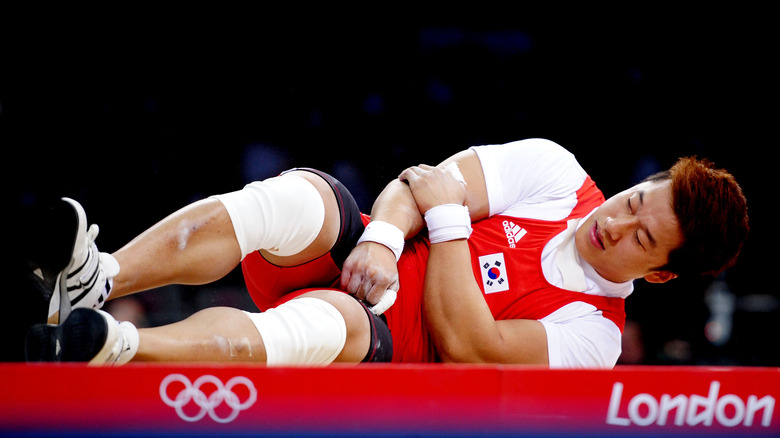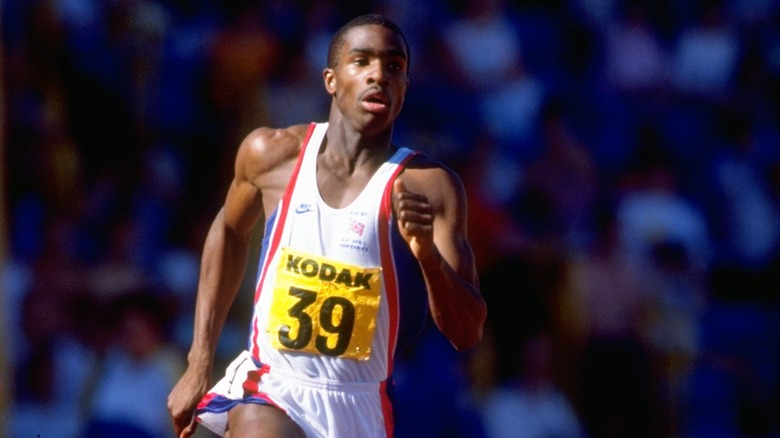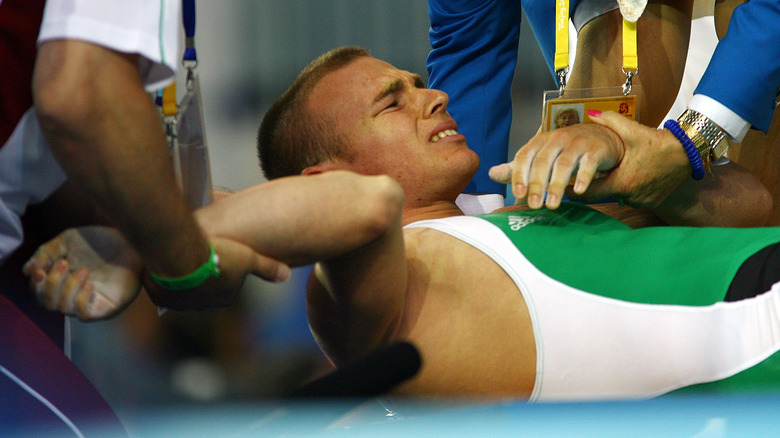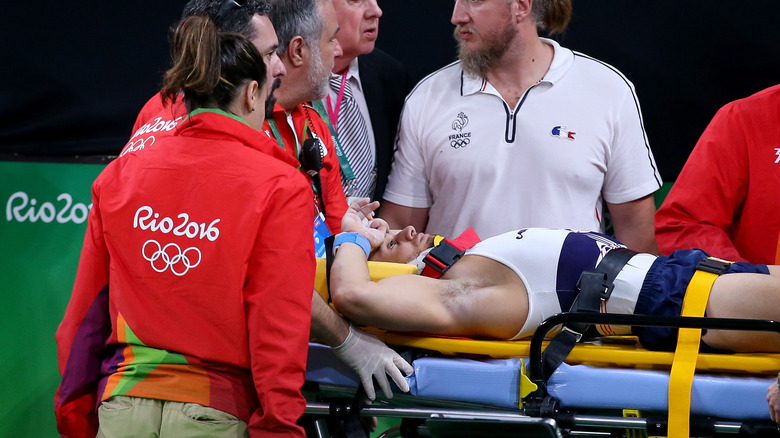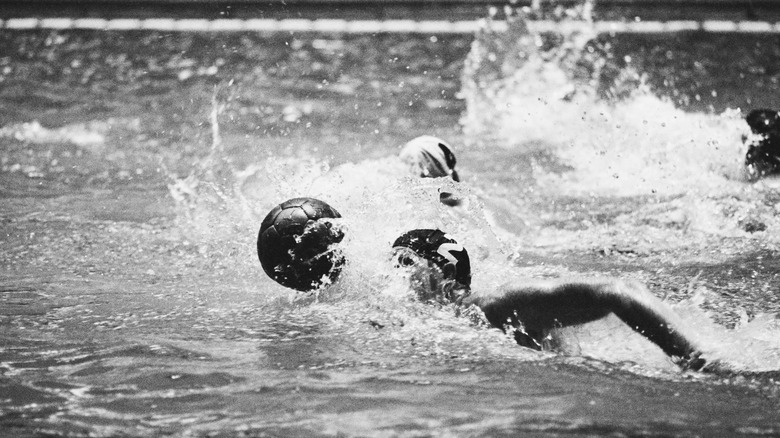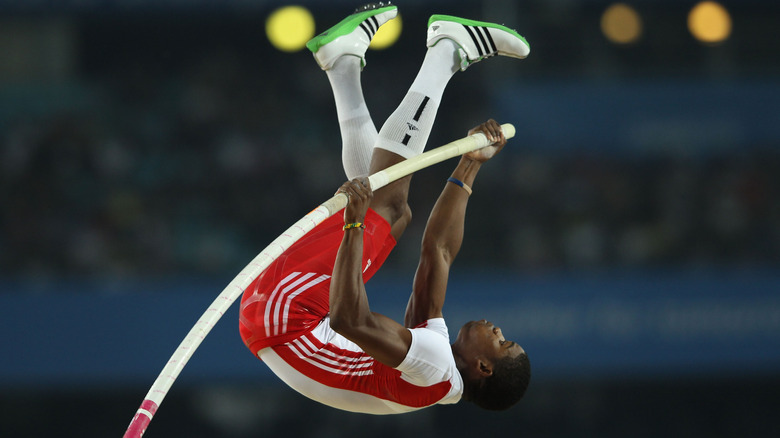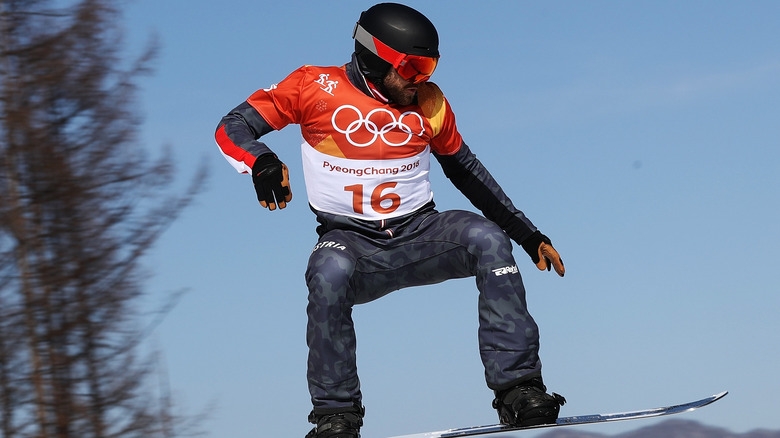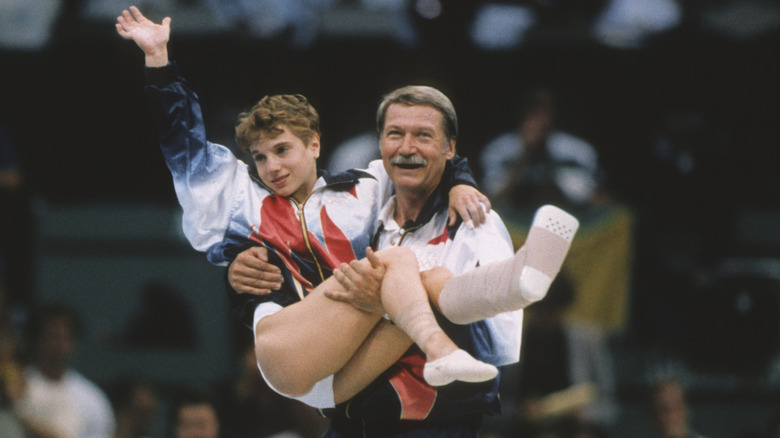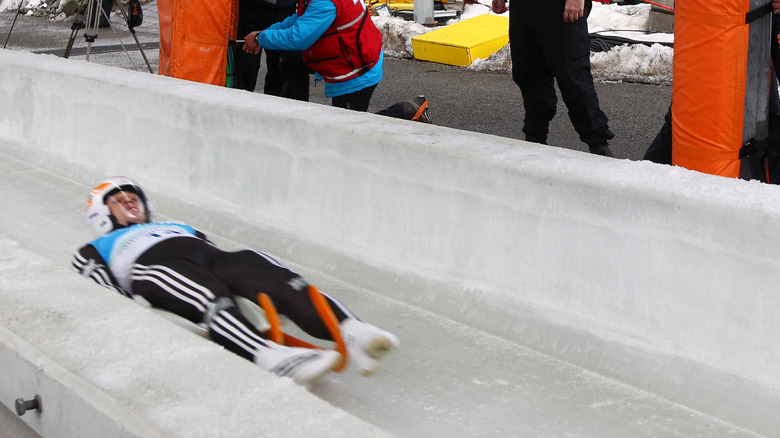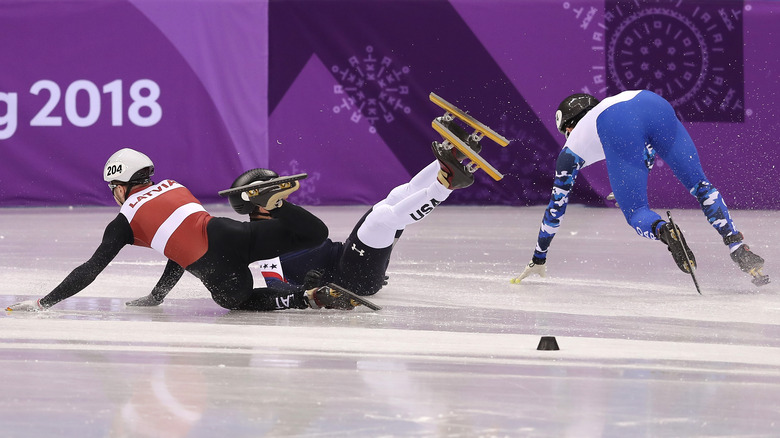The Worst Injuries That Have Happened During The Olympics
Behind your favorite Olympians are years of practice, countless hours of training, and in many cases, injuries. Some accidents occur during training, some during trial runs before the actual games. On occasion, some occur during the Olympic games themselves (via HuffPost). With international media covering the Olympics, athletes who endure injuries during the games have cameras on them from all angles. These cameras capture the most horrific and sometimes career-ending moments throughout the games.
The level of severity of injuries varies and is often sport-dependent. As we scoured the internet and history books to determine the worst of the worst Olympic accidents, we noticed one remarkable trend: Nearly all of the most grizzly Olympic injuries happened during the winter Olympics. From dislocated elbows to concussions to gory lacerations, these Olympic athletes left behind more than just athletic glory.
Exploring the worst injuries to happen during the Olympics isn't for the faint of heart, but if you're injury-curious like us, read on to learn about some of the most gruesome accidents of Olympic history.
Nancy Kerrigan's leg injury
Perhaps one of the most notable and horrific "accidents" to occur on the road to the Olympics happened to Nancy Kerrigan. While she sustained only bumps and bruises, the darkness and deceit behind the attack are everlasting.
On January 6, 1994, Kerrigan was physically attacked by a hitman. Kerrigan's figure skating rival, Tonya Harding's ex-husband and bodyguard, hired a literal hitman to strike Kerrigan's leg in hopes of hindering her skating performance (via Biography). The hitman deployed a collapsible baton and took a crack at Kerrigan's right leg practice. The skating rivals were practicing for an event to compete to join the US Olympic team. Although she did not experience any broken bones, Kerrigan's leg injury was severe enough that she was forced to pull out of the national competition set to take place the following night. Harding won the gold medal the night after the attack, securing her spot on the Olympic team.
Kerrigan's optimism and poise so moved teammates that they offered her a spot on the Olympic team. In February 1994, both women took the ice. Kerrigan took home a well-deserved silver medal. She-who-will-not-be-named finished in 8th place and went on to plead guilty of "conspiracy to hinder prosecution" (per Biography). She was banned from the United States Figure Skating Association for life. However, Harding did receive notoriety because of the scandal. Her unsportsmanlike conduct is recounted in the 2017 movie "I, Tonya."
Sa Jae-Hyouk's horrifying elbow injury
In 2012, South Korean weightlifter Sa Jae-Hyouk endured a severe elbow injury while defending his Olympic title (via HuffPost). For some background, two types of lifts are performed in the Olympics: the snatch and the clean and jerk. Snatching can best be described as weightlifting squats to pick up a heavy-*ss barbell. Weightlifters must then seamlessly hoist it overhead while landing in a squat position. Then they need to generate all of their power and rise to a standing position with the barbell overhead.
Sa's first snatch of the 2012 summer Olympics went well, and he was on track to earn a medal. During his first lift, he successfully lifted 350 pounds over his head. During his second of three attempts, however, things went wrong. With the weight bumped up to 357 pounds, Sa buckled beneath the pressure and endured a gruesome elbow dislocation (via HuffPost).
Jarring videos captured during his attempt show him successfully lifting the weight overhead and then dropping it behind him almost immediately while squatted (via Buzzfeed). He cried out in pain and dropped to the ground. Shortly after that, Sa underwent surgery and resumed his career. You won't see him in Tokyo for the 2020 Olympic Games, though. Sa was issued a 10-year ban from the sport after allegedly assaulting another weightlifter, BBC reported.
Derek Redmond's hamstring injury
It would perhaps be weird to say that we have a "favorite" Olympic injury, but Derek Redmond's 1992 injury has a heartwarming ending. Redmond was favored to medal in Barcelona in the 400 meters. He walked into the semi-finals confident and ready to represent Great Britain. In Redmond's recounting of the story, he said that about 100 meters into the race, he heard a resounding "pop" (via Olympics). He said he assumed that the noise came from the crowd, but after a few more strides, the reality of what had occurred hit him. He knelt on the track with an aggressive hamstring injury.
After a moment, he stood and began to hobble down the track. His hobbling is probably a lot faster than we could run, TBH. His mental fortitude was plainly visible as he limped toward the finish line. His dad ran out onto the track and looped his arms around Redmond. Together, they finished the race amid cheers from the crowd (per Olympics). Since his dad helped him finish, Redmond's official race results read "DNF" (Did Not Finish), according to AP News.
Redmond competed after this event but ultimately found his place as a professional basketball player for the Birmingham Bullets. As of this writing, he is a motivational speaker (per Scroll). No matter how many times we hear his story, we well up at his sportsmanship, tenacity, and perseverance. Redmond is nothing short of a living legend.
Janos Baranyai's gruesome elbow dislocation
Like Sa Jae-Hyouk, Janos Baranyai is an Olympic weightlifter who lost his battle with the barbell. Baranyai took the platform to represent Hungary in the 2008 Beijing Olympics. While attempting to lift around 326 pounds over his head, he dislocated his right elbow (via ESPN). The elbow buckled beneath the weight and his cries of agony echoed throughout the stadium. Fortunately, Baranyai was able to recover without surgery. He resumed competition at full force shortly after experiencing the gruesome injury.
In addition to getting back into competing, he got to get a tattoo of the Olympic rings along with the text "Beijing 2008" as a reminder. However, the world would never be able to forget this injury. What made it especially hard to watch is that as his elbow gave out, he fell forward. As he dropped to the ground, the barbell crashed down onto his back, causing a painful secondary injury. The video (warning: graphic content) of Baranyai's injury is one of the most-watched Olympic injury videos of all time (via ESPN).
Samir Ait Said's shattered leg
Samir Ait Said of France executed a memorable vault routine at Rio in 2016. Unfortunately, it isn't memorable because of how perfectly it went. Said made it through a gravity-defying routine before the entire arena heard a crack as his left leg shattered upon landing. Said's lower leg dangled from the knee at an awkward angle as he lay on the mat composing himself (via USA Today).
Medical personnel rushed to his side. It was later confirmed what all of us watching hoped not to be true: Said broke his tibia and fibula, the two bones of the lower leg. A few years before, Said had been unable to compete in the 2012 Olympics due to a broken tibia on his right leg. That injury was also sustained on the vault.
Despite a painful recovery from multiple compound fractures and the devastating death of his father in 2019, Said set his sights set on Tokyo. And as USA Today revealed, "Ait Said's performance on still rings Saturday [July 24] was smooth, showing both his strength and his precision."
Kevin Pearce's traumatic brain injury
Kevin Pearce, a U.S. snowboarder, suffered one of the worst injuries in Olympic history. Pearce was favored to medal in the 2010 games in Vancouver when his dreams came crashing down. During a training run in Park City, Utah, Pearce's snowboarding career ended for good (via Today). He was 22 years old at the time.
Pearce suffered a traumatic brain injury and went on to spend nearly a week in a coma before a 26-day stint in the ICU (via Neurologic Rehabilitation Institute). Pearce slowly regained his confidence, identity, and abilities, all recounted in his 2013 film, "The Crash Reel." Two years after the accident, Pearce did strap his board to his feet again, only to be hit with the reality that his snowboarding career was truly over.
Pearce went on to co-found a nonprofit called LoveYourBrain. This foundation helps people who've experienced traumatic brain injuries and their families navigate grief and recovery. Pearce's injury transformed his life, and he is finding purpose in helping others who endured similar injuries (per Today).
Ervin Zador: Blood in the Water
We had to roll back the history tapes to find this Olympic event. The historical significance is overwhelming, making this bloodbath (aptly called "Blood in the Water") all the more interesting yet terrifying (via BBC). Ervin Zador was 21 in 1956 when he took to the Olympic Games to compete for Hungary in water polo. Hungary was under Soviet rule at this point in history, and an uprising was already well underway. The Soviets brutally ended an anti-Soviet rally only weeks before. The tension between countries was at an all-time high.
On that fateful day in '56, Hungary and the USSR met in the pool to compete. As the tension and weight of the rivalry came to a head, Zador was repeatedly punched by a Russian player. He emerged from the pool with blood dripping down his face, knowing that the Hungarian team was well in the lead.
The Hungarian water polo team went on to win in the Olympic finals against Yugoslavia. Zador sat out the final match, and after the games, he let Hungary and never returned. Hungary gained its independence from Soviet rule later that year, BBC News reported.
Lazaro Borges' near miss
Cuban pole vaulter Lazaro Borges didn't actually sustain a gnarly Olympic injury. But what happened to him during the qualifying round at the 2012 games is too notable to pass over due to what could've been a fatal accident. Borges' fiberglass pole snapped into three separate pieces as he attempted to launch himself some 17 feet into the air (via HuffPost). This occurred during the qualifying round of the London games. The crowd waited with bated breath as Borges tumbled toward the earth below him.
Borges did half of a somersault and landed on his back with his chin tucked to his chest. Miraculously, Borges didn't land atop any of the debris from his pole. Any of the pieces could have caused irreversible damage. Instead, he landed squarely on the landing mat, narrowly avoiding what may have been a career-ending (or life-ending) crash. Borges cleared the same height on his third attempt. He continued to compete after the London Games, but not at the Olympic level.
Markus Schairer's broken neck
Austrian snowboarder Markus Schairer is no stranger to injury. He is yet another athlete who launches himself high into the air during practice and competitions. During the 2018 men's snowboard cross quarterfinals, Schairer lost control coming off of a jump. Right before his crash, he was in a position to medal.
The video of his tumble is painful to watch. The athletes fly through the air, most of them stomping their landings and continuing the race. Schairer, unfortunately, ends up perpendicular to his line and biffs it — hard. He landed on his back, and spectators watched in horror as his head bounced back and forth so hard that his goggles broke loose.
In an incredible show of strength, Schairer rights himself and finishes the race. He walked away with one broken cervical vertebra. In laymen's terms: He broke his neck. Heartbreaking crash aside, Schairer healed up well and was left with no neurological damage (via CBS Sports).
Annemiek van Vleuten's devastating fall
Dutch cyclist Annemiek van Vleuten was 10 kilometers away from taking gold when she lost control of her bike during a descent. Another athlete wiped out at the same spot in an earlier race, the course has since endured a ton of criticism (via The Guardian).
The steep and dangerous descent got the better of van Vleuten. She crashed and lay motionless while riders sped past her towards the finish line. The replay of the event shows the precise moment when her bike started to wobble. She flipped over the handlebars and appeared unconscious with her legs atop the curb and her head and shoulders tucked beneath her on the road (per The Guardian).
The cyclist spent a night in the ICU and emerged with three spinal fractures, a severe concussion, and numerous bumps and bruises, Reuters revealed. She has since recovered and even went on to compete in the Olympic Games in Tokyo, where she won a silver medal (via CNN).
Nicolas Bochatay's fatal accident
One of the worst Olympic accidents in history took place in 1992, three hours before the competitive event was meant to take place. Swiss skier Nicolas Bochatay was warming up with his teammates and competitors before things went south.
Bochatay hit his enormous warmup jump wearing slalom skis. He was going fast, though not as fast as he typically skied in his speed-skiing gear. For reference, speed skiers frequently top out at speeds around 135 miles per hour. Bochatay, who was 27 at the time, launched himself off of the jump and met a crash landing as he skidded into a parked snowplow. Other skiers who witnessed the accident claim that the height of the jump hid the Snowcat, a snow-grooming vehicle. Many of those same witnesses confirm that they watched the whole event unfold as if it were in slow motion. Many other bystanders were shouting and waving for the skiers to tell Bochatay to stop as they could see how dangerous his trajectory was. Sadly, due to the numerous injuries he sustained, Bochatay died at the scene (The Washington Post).
Kerri Strug's ankle injury
Kerri Strug was a young gymnast in 1996 when she competed in the games in Atlanta, Georgia. As the pressure of the games mounted, the weight of the USA's ranking rested firmly on Strug's shoulders. Sadly, her first vault attempt ended with her ankle buckling beneath the weight of her body on her landing. She composed herself and vaulted a second time, only this time with an injured ankle. She sprinted down the runway with incredible grace and determination. Not only did she complete her run with only a slight waver in her landing, but she also secured a gold medal for Team USA. This event was all the more impressive because Strug's performance earned the U.S. a gymnastics gold medal for the first time ever (via Olympics).
After landing, she lifted her injured leg and posed for the crowd with tears in her eyes. She then collapsed to the mat and was later carried to the podium to receive her medal. She sustained "a third-degree lateral sprain and two torn ligaments," according to The Baltimore Sun, and her story of power and grit continues to resonate worldwide.
Nodar Kumaritashvili's fatal luge accident
Nodar Kumaritashvili's 2010 crash goes down in history as one of the most tragic Olympic accidents of all time. Not only that, it happened in relatively recent history and with cameras surrounding him. The footage is chilling. Kumaritashvili was a promising 21-year old Georgian luger who hopped into his sled to complete his final training run before the Olympic Games got underway.
Sadly, Kumaritashvili's final practice run ended up being his final run. He lost control of his sled as he rounded a corner. This specific corner had been criticized repeatedly, with many athletes asking questions about its safety (via CNN). The course was devised in such a way that made it challenging for athletes to temper their speeds. Some experts speculated that some luge athletes would hit record-breaking, triple-digit speeds during the 2010 games.
Kumaritashvili rounded the 16th and final turn as he lost control. He was thrown from his sled while traveling at a speed of 88 miles per hour. After being thrown from the course and hitting a pole, he remained unconscious as medical personnel performed CPR on him. Emergency teams were unable to revive him (via CNN).
J.R. Celski's horrific thigh gash
Speed skating is kind of like figure skating's aggressive older cousin. The athletes rip around the track with ginormous blades attached to their feet. As with most sports performed on ice (except for possibly curling), skating on ice comes with a risk of a crash landing.
J.R. Celski of the USA is an experienced short-track speed skater who suffered a major injury in a trial run leading up to the Vancouver Olympics. Celski's right skate blade punctured his left thigh during a tumble around a corner. The blade sliced a muscle in half, and his parents and fans watching quickly noticed blood pouring from his leg into the ice, according to NBC (warning: graphic content).
Thankfully, the gash missed his femoral artery — but only by a mere inch and required over 60 stitches (via USA Today). Celski recovered quickly, his determination ever-present. He went on to win two gold medals in Vancouver that year. He then earned a silver medal in Sochi four years later. He also raced in the PyeongChang Olympics in 2018, though he returned home without a medal. He announced his retirement from the sport soon after, per USA Today.

